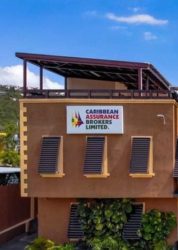The volume and value of stocks traded on the Trinidad and Tobago Stock Exchange on Monday fell 90 percent and 92 percent, respectively, compared to Friday, resulting in mixed movements in the market indices.
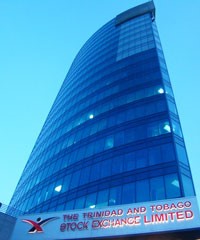 The market closed with 11 securities trading, down from fifteen on Friday, and closed with three stocks advancing, four declining and four remaining unchanged. Trading resulted in 62,793 shares for $849,435 compared to 602,518 shares valued $10,526,304 on Friday.
The market closed with 11 securities trading, down from fifteen on Friday, and closed with three stocks advancing, four declining and four remaining unchanged. Trading resulted in 62,793 shares for $849,435 compared to 602,518 shares valued $10,526,304 on Friday.
The average trade for the day amounted to 5,708 units at $77,221 versus an average of 40,168 units at $701,754 for each security on Friday. October closed with an average of 16,922 shares for $285,061.
The T&T Composite Index fell by 1.68 points to 1,304.83, the All T&T Index gained 0.26 points to 1,754.72, while the Cross Listed Index lost 0.50 points to close at 115.55.
The Investor’s Choice bid-offer indicator ended with bids of four stocks closing higher than their last selling prices and four with lower offers.
Stocks rising│Guardian Holdings added 10 cents to finish at $20.10, in trading 2,192 stock units, Republic Financial Holdings closed 20 cents higher at $141.50, with an exchange of 20 units and Trinidad & Tobago NGL gained 5 cents to end at $15, after a transfer of 82 units.
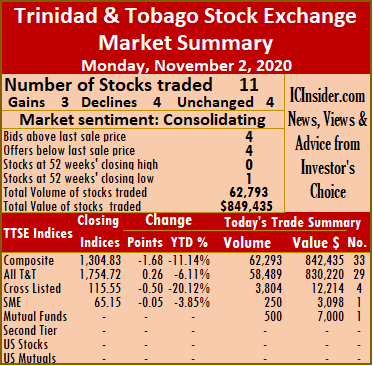 Stocks declining│Endeavour Holdings shed 1 cent to settle at an all-time low of $12.39, in exchanging 250 units, First Citizens Bank lost 3 cents trading 3,362 stock units to close at $44.50, JMMB Group lost 5 cents and ended at $1.75, with 800 units crossing the exchange and National Enterprises lost 2 cents transferring 10,833 shares at $3.90.
Stocks declining│Endeavour Holdings shed 1 cent to settle at an all-time low of $12.39, in exchanging 250 units, First Citizens Bank lost 3 cents trading 3,362 stock units to close at $44.50, JMMB Group lost 5 cents and ended at $1.75, with 800 units crossing the exchange and National Enterprises lost 2 cents transferring 10,833 shares at $3.90.
Stocks trading firm│Calypso Macro Index Fund exchanged 500 units at $14, Grace Kennedy closed at $3.60, with 3,004 stock units crossing the market, One Caribbean Media traded 10,000 shares at $4.85 and Unilever Caribbean remained at $17, with 32,000 shares changing hands.
Prices of securities trading are those for the last transaction of each stock unless otherwise stated.



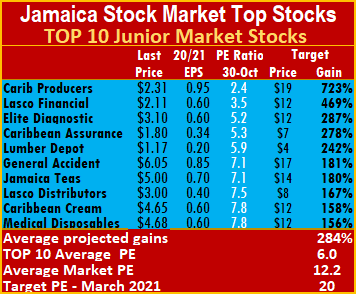
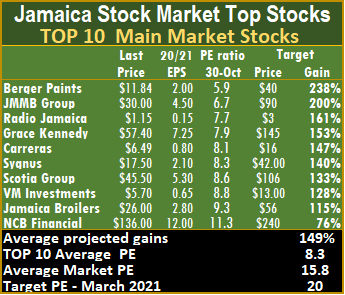 Remittances grew 11 percent and added $50 million to revenues while Cambio operations contributed 10.8 percent or $34 million to increased revenues, the company’s Managing Director Jacinth Hall-Tracey, informed shareholders in a commentary accompanying the quarterly report.
Remittances grew 11 percent and added $50 million to revenues while Cambio operations contributed 10.8 percent or $34 million to increased revenues, the company’s Managing Director Jacinth Hall-Tracey, informed shareholders in a commentary accompanying the quarterly report. With expected gains of 161 to 238 percent, the top three Main Market stocks are now Berger Paints followed by JMMB Group, Radio Jamaica replacing Grace Kennedy in the third position last week.
With expected gains of 161 to 238 percent, the top three Main Market stocks are now Berger Paints followed by JMMB Group, Radio Jamaica replacing Grace Kennedy in the third position last week.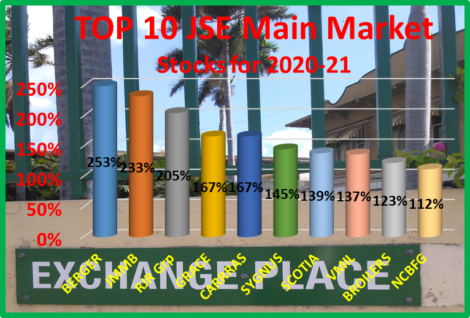 The average projected gain for the Junior Market IC TOP 10 stocks is 287 percent, and 149 percent for the JSE Main Market, based on 2020-21 earnings, indicates potentially greater gains in the Junior Market than the Main Market.
The average projected gain for the Junior Market IC TOP 10 stocks is 287 percent, and 149 percent for the JSE Main Market, based on 2020-21 earnings, indicates potentially greater gains in the Junior Market than the Main Market.


